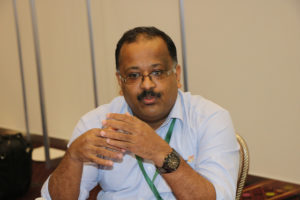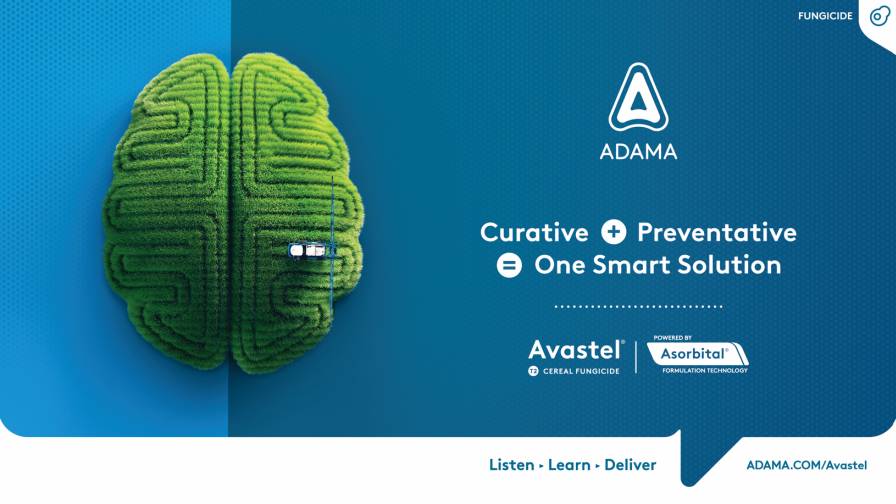Coromandel: Beyond Fertilizer to Solutions Provider
Coromandel’s Roshan Mammen, Associate Vice President & Head Exports – Global, and S. Srikanthan, Chief Operating Officer of the Crop Protection Division, sat down with Senior Editor Jackie Pucci at the AgriBusiness Global Trade Summit in Las Vegas to discuss the Indian market and what’s next for the company.
How do you set yourselves apart from other Indian manufacturers?
Mammen: Most of our visibility comes through fertilizer, but it’s actually not the case. We are the only company that is a solutions provider in India. If you see our business, we do everything in India, except seeds. We have fertilizers, specialty nutrients, crop protection, technical services, and farm equipment. We have our own farm retailer business. We are today the only Indian company that’s been successful in retail services. We have around 450 of our own retail stores, owned and operated by the company. The stores’ positioning is as a solution provider, so the farmer walks in for advice on product to services. He gets everything at that store. It’s the reputation of the store, and is an umbrella brand spreading across the country. We are present more in the South of India, but we are slowly getting more in the West and will probably access other markets.
You will not see a fertilizer company into agrichemicals who is also doing well. We are growing well and are known in the market and the crop protection space also. We are one of the very few in that space, and that’s the unique space we enjoy.
At the end of the day, your client is the same. You’re addressing the needs of the farmer. From that perspective, we have a little more rounded knowledge of how the farmer is evolving: how his fertilizer needs are evolving, how his crop protection needs are evolving. We get more rounded view on that because of our presence in those segments.
How much of the business is fertilizer, and how would you characterize your business model?
Mammen: The total business is $1.8 billion; crop protection is $250 million. The rest is fertilizer. In the crop protection business, roughly 45% of our business comes from exports. Today we are present directly in six countries where we have subsidiaries and own our own registrations. But our business model is that we are more in the B-to-B space; we are not in the retail or distribution space in any country. What we do best is manufacture. In large markets, we put up a subsidiary and do the registrations. Then we look for channel partners who will take our products to the market.
We are slowly expanding our presence into more key countries. This year we opened two subsidiaries in Nigeria and in Mali. We are looking at two more in Africa and two additional locations in Asia-Pacific. In Latin America we have a direct presence in Mexico, Argentina, Brazil, and are looking at one more in the Andean region. We will have four subsidiaries in Africa apart from the two we already have and another three in Asia. So footprint-wise, we will be there. Then it’s only providing the right products.
Accessing the channel directly is a debate which we keep having internally, but we still feel that if you’re working with the right partner for marketing your product, you do what is best and they do what they know best – I think it’s the right marriage. We still believe in that.
What individual products do you want to highlight and can you discuss your biggest exports?
Mammen: Our most popular and largest product volume-wise is mancozeb. Mancozeb came to us with the acquisition of Sabero in 2011. Post that, we’ve done more registrations, expanded the plant, and set up a new plant. Capacity today is around 45,000 tonnes, all manufactured in India between two plants. We manufacture 17 active ingredients in India total. Principal products we export are the mancozeb family products: mancozeb, maneb, zineb, propanib, and similar products. Acephate and chlorpyrifos are also key products we export, along with profenofos, malathion, and phenthoate – it’s a long list. Our weakest link is herbicides. This is one segment we are working on to round out our portfolio.
We have identified five principal crops globally that we will be focusing on: soybean, corn, fruits and vegetables, cotton, and sugarcane – as well as rice, mainly for the Asian market, so we will be developing our portfolio based on these. We have an R&D team with roughly 20 scientists who work on post-patent products, so they do the reverse engineering, find a better way to make those products, and work on combination molecules and new, safer formulations. The next three to five years is an evolution time for us where we are really going to be moving these molecules to market, and the impact will be significant on our results.
Do you see the Indian landscape of small, fragmented farms changing?
Mammen: It has not changed, but what probably would change is access to information. The younger farmers are a little bit more technology-oriented. What is changing is mechanization of the farm with drone technology and other convenient technologies that are coming in. Managing the farm will become easier. Earlier, mechanization meant you needed to have a minimum landholding to run a large tiller or tractor operator. Now with drone technology coming in, you can do precision farming even for a small farm. I think that’s what the young farmer is looking at: how to cut his costs of operation and still be more effective.
One big gap today in India today for the farmer to make his business remunerative is the ability to sell his produce. That’s the biggest challenge for an Indian farmer, because that’s where he’s not able to capture the full value. If you look at Brazil, the farmers are very strong at selling – they sell to the commodity traders and know how the prices are moving. Whereas for the Indian farmer, he hardly gets 20% to 30%, or even less, of what the end consumer pays for the produce.
What is the main obstacle on that front?
Mammen: It’s the structure. It’s the middlemen who buy the produce. That fabric of the commodity segment has to evolve more in India for the farmer to get more remunerative on his operation. Otherwise, on the input side, I think a lot of companies are providing enough services. Other large companies like us are educating farmers, getting good products to them, and making farming a little bit less expensive. Finally, the output has to get in the right place. Only then will the whole value chain be covered.
What is your perspective on the Make in India plan?
Srikanthan: It’s about manufacturing progress. What the pharmaceutical industry was 20 years back, the agrichemical industry is today. If you look at when pharma was dominating patented molecules it was Pfizer, Merck, and the European companies. Indian companies started very small in the ‘90s and are a big player to reckon with today – pharma is close to a $30 billion market today. There is a huge amount of skillset in terms of research in the field of chemistry. Pharma and agrichemicals aren’t that much different. Ten to 15 years down the line India should become a powerhouse also in agrichemicals. Some of the names may not be visible today, but there are many companies that have done extremely well.
How close is the plan to being implemented? In what areas would Indian companies have more trouble competing with the Chinese?
Srikanthan: The Make in India plan is only six to seven months old. Any change takes time. Sometimes you rush to get things done faster, but sometimes you realize that hey, probably we are not there. In one to two years India will settle in. I think we are in the early phases of realizing what is and what isn’t possible. I think the government is very sensible. They are open to feedback – they are willing to look at it in a different perspective from what was originally planned.
We will evaluate what is feasible within ourselves, because there are some chemicals that are backward-integrated so well. There’s no point in starting out fresh from zero-level. We will be very clear in terms of what we can do, in terms of our skillset. Definitely, for some of the classical, older molecules for which the Chinese have economies of scale and years of mastering the learning curve, we will not be getting into those. I think there’s a good amount of understanding in both of our countries.
How do you see the impact of mega-mergers playing out, including the potential for consolidation among Indian companies?
Srikanthan: For consolidation happening at the global level, there could be some molecules dropped, so it could be an opportunities for others. In terms of the role of China and Syngenta, ChemChina, and Adama – each one has a different business model, so how they are going to pull it off together in another three to four years is the real billion-dollar question.
Coming back to Indian companies, entrepreneurs have driven the space for the last 30 years. Forty to 50% of the turnover is controlled by them today. As their aspirations and ambitions grow bigger, we expect a lot of consolidation and being sold out to the multinationals. I think this is the phase all industries go through. The last three to four years has been an interesting phase for the agrichemical industry in India in terms of many of the companies being sold out or becoming partners with the Japanese or other Indian companies – I think the trend will continue.
Do you see biocontrols playing a larger role for the company and for Indian farmers?
Mammen: From our perspective, we don’t see it as a big growth pyramid. I think it’s a supplement to what the farmer uses. In India, integrated pest management has always been promoted – you should have a mix to reduce dependence on chemicals and use biocontrols as a way to manage your pest cycle. But if you say it would replace something, I think it’s the wrong way to promote it.
We have our own organic business, but we provide organic fertilizers as a supplement to our chemical fertilizers. At the end of the day, you cannot do with only one – you have to have a balance. I think that’s more on the education front, and that’s where our stores play a role and where farmers can come and we educate them on these parameters. As a segment, (biocontrols) will definitely grow, but not at the cost of something else.








